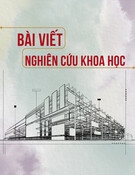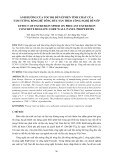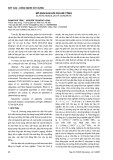
Journal of Science and Transport Technology Vol. 1 No. 1, 34-44
Journal of Science and Transport Technology
Journal homepage: https://jstt.vn/index.php/en
JSTT 2021, 1 (1), 34-44
Published online 07/12/2021
Article info
Type of article:
Original research paper
DOI:
https://doi.org/10.58845/jstt.utt.2
021.en.1.1.34-44
*Corresponding author:
E-mail address:
banglh@utt.edu.vn
Received: 13/10/2021
Revised: 30/11/2021
Accepted: 02/12/2021
Estimation of the bond strength between FRP
and concrete using ANFIS and hybridized
ANFIS machine learning models
Thuy-Anh Nguyen, Hai-Bang Ly*
University of Transport Technology, 54 Trieu Khuc, Thanh Xuan, Hanoi 100000,
Vietnam
Abstract: Adaptive Neuro-Based Fuzzy Inference System (ANFIS) and
Particle Swarm Optimization (PSO) algorithms were utilized to produce
numerical tools for predicting the bond strength between the concrete surface
and carbon fiber reinforced polymer (CFRP) sheets. From the relevant
literature, a credible database encompassing 242 test specimens was
developed, along with six input factors that primarily determine bond strength.
These characteristics include the beam's width, the compressive strength of
the concrete, the FRP thickness, the FRP modulus of elasticity, the FRP length,
and the FRP width. Finally, using conventional statistical metrics, the outputs
of the two suggested models (ANFIS and ANFIS-PSO) were compared to the
experimental data. Both models were shown to be a good alternative strategy
for predicting the bond strength of FRP-to-concrete.
Keywords: Bond Strength; FRP-to-concrete; Adaptive Neuro-Based Fuzzy
Inference System (ANFIS); Particle Swarm Optimization (PSO).
1. Introduction
Reinforced concrete is one of the most
commonly used construction materials because of
its strength, ease of application, adaptability,
flexibility, durability, and affordable price. However,
in complicated weather conditions, intense
aggressiveness of the environment causes steel
rusting, peeling of the protective concrete layer,
and reducing the reinforced concrete bearing
structure system [1]. In addition, the changes due
to user requirements often tend to be detrimental
to existing structures requiring the implementation
of solutions to repair, upgrade or even replace the
structure. At that time, repairing and upgrading are
often practical solutions because replacing a series
of works requires significant costs. Therefore, the
development of repair and reinforcement
technology solutions to maintain and restore the
normal working of reinforced concrete structures is
highly necessitated.
In recent times, repairing and reinforcing
works by using fiber reinforced polymers (FRP) in
sheet form is a solution that has been widely
studied and applied [2,3]. This method takes
advantage of the properties of FRP materials such
as high strength and corrosion resistance, high
durability, non-magnetic, and has a higher
strength-to-weight ratio, which reduces the self-
weight of an RC structure and high fatigue
resistance. In addition, the convenience of
construction, high aesthetics, ensuring the
preservation of the old structural shape (because
FRP sheets can be quickly bonded with structures
of any cross-section), suitable for projects that






























